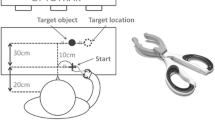Abstract
We investigated how people control fast, accurate movements of a load using a simple two-hand grasp. By providing a clear instruction to several subjects, we isolated a single control strategy. The kinematics produced by this control strategy are nearly indistinguishable from those produced during single-hand movements, but the torques are quite different: one hand accelerates not only itself, but also the load and the other hand, while the other hand brakes the hand-load-hand system. As a result, the hands squeeze the load with a large force during the movement.
The dynamics of the hand-load-hand system are of the same form as the dynamics of a single-hand system. Apparently, by taking advantage of this dynamic similarity and of the spring-like properties of muscle, the human motor control system can control the two-hand grasp system simply by modifying the muscle activation patterns used to control single-hand movements.
The task dynamics of two-hand grasp do not require that the load be squeezed during the movement, and squeezing the load wastes torque that could be used to move more quickly. However, the human motor control system may choose this squeezing strategy because it reliably brakes the hand-load-hand system despite inherent variability in the braking of individual hands.
Similar content being viewed by others
References
Cole KJ, Abbs JA (1988) Grip force adjustments evoked by load force perturbations of a grasped object. J Neurophys 60:1513–1522
Di Benedetto M (1990) Nonlinear strong model matching. IEEE Trans Aut Ctrl 35/ 12:1351–1355
Fitts PM (1954) The information capacity of the human motor system in controlling the amplitude of movement. J Exp Psychol 47:381–391
Georgopoulos AP, Grillner S (1989) Visuomotor coordination in reaching and locomotion. Science 245:1209–1210
Gottlieb GL, Corcos DM, Agarwal GC, Latash ML (1990) Principles underlying single-joint movement strategies. In: Winters JM, Woo SL (eds) Multiple muscle systems. Springer-Verlag, Berlin Heidelberg New York, pp 236–250
Grillner S (1975) Locomotion in vertebrates: central mechanisms and reflex interaction. Psych Rev 55:247–304
Grupen RA, Henderson TC, McCammon ID (1989) A survey of general purpose manipulation. Int J Rob Res 8:38–62
Hamming RW (1983) Digital filters. Prentice Hall, Englewood Cliffs, New Jersey, p 120
Hollerbach JM (1982) Computers, brains, and the control of movement. TINS June: 189–192
Jeannerod M (1988) The neural and behavioral organization of goal-directed movements. Oxford Psychology Series no. 15, Clarendon Press, Oxford
Johansson RS, Westling G (1988) Coordinated isometric muscle commands adequately and erroneously programmed for the weight during lifting task with precision grip. Exp Brain Res 71:59–71
Jones LA (1986) Perception of force and weight: theory and research. Psych Bul 100:29–42
Lehman SL, Calhoun BM (1990) An identified model for human wrist movements. Exp Brain Res 35:391–8
Li Z, Hsu P, Sastry S (1989) Grasping and coordinated manipulation by a multifingered robot hand. Int J Rob Res 8:33–50
Lum PS, Reinkensmeyer DJ, Lehman SL, Li PY, Stark LS (1992) Feedforward control in a bimanual load-lifting task. Exp Brain Res 89:172–180
Markenscoff X, Ni L, Papadimitriou CH (1990) The geometry of grasping. Int J Rob Res 9:61–74
Murray RM, Sastry SS (1990) Grasping and manipulation using multifingered robot hands. In: Brockett RW (eds) Robotics: proceedings of symposia in applied mathematics, vol 41. American Mathematical Society
Nakamura Y, Nagai K, Yoshikawa T (1989) Dynamics and stability in coordination of multiple robotic mechanisms. Int J Rob Res 8:44–61
Nashner LM Analysis of stance posture in humans. In: Towe AL, Luschei ES (eds) Handbook of bheavioral neurobiology, vol 5. Plenum, New York, pp 527–565
Nguyen VD (1988) Constructing force closure grasps. Int J Rob Res 7:3–16
Paulignan Y, MacKenzie C, Marteniuk R, Jeannerod M (1990) The oupling of arm and finger movements during prehesion. Exp Brain Res 79:431–435
Raibert M (1986) Legged robots that balance. MIT press, Cambridge
Zahalak GI (1990) Modeling muscle mechanics (and energetics). In: Winters JM, Woo SL (eds) Multiple muscle systems. Springer-Verlag, Berlin Heidelberg New York, pp 1–23
Author information
Authors and Affiliations
Rights and permissions
About this article
Cite this article
Reinkensmeyer, D.J., Lum, P.S. & Lehman, S.L. Human control of a simple two-hand grasp. Biol. Cybern. 67, 553–564 (1992). https://doi.org/10.1007/BF00198762
Received:
Accepted:
Issue Date:
DOI: https://doi.org/10.1007/BF00198762




